Fukushima: Japan allows residents of Naraha to return four years after disaster
Naraha represents a test case, as health concerns make most residents cautious

Your support helps us to tell the story
From reproductive rights to climate change to Big Tech, The Independent is on the ground when the story is developing. Whether it's investigating the financials of Elon Musk's pro-Trump PAC or producing our latest documentary, 'The A Word', which shines a light on the American women fighting for reproductive rights, we know how important it is to parse out the facts from the messaging.
At such a critical moment in US history, we need reporters on the ground. Your donation allows us to keep sending journalists to speak to both sides of the story.
The Independent is trusted by Americans across the entire political spectrum. And unlike many other quality news outlets, we choose not to lock Americans out of our reporting and analysis with paywalls. We believe quality journalism should be available to everyone, paid for by those who can afford it.
Your support makes all the difference.Japan is allowing residents of the town of Naraha to return after being evacuated more than four years ago, following the 2011 disaster at the nearby Fukushima nuclear plant.
Naraha has become the first town among seven municipalities in the area to get the order lifted after the mass evacuation from radiation contamination in the massive earthquake and tsunami that sent the plant’s reactors into triple meltdowns in March 2011. The central government has said radiation levels in Naraha have now fallen to safe levels, following decontamination efforts.
Naraha represents a test case, as health concerns make most residents cautious. In addition, there is still a lack of infrastructure here: a segment of the railway is still out of service – with the tracks covered with grass – some houses are falling down, and wild boar roam at night.
According to a government survey, 53 per cent of the evacuees from Naraha, which is around 12 miles south of the plant, say they’re either not ready to return home permanently or are undecided. Some have found jobs elsewhere over the past few years, while others cite radiation concerns. Only about 100 of the nearly 2,600 households have returned since a trial period began in April.
Yukiei Matsumoto, the mayor of Naraha, said that the lifting of the order marked an important milestone. “Our clock started moving again,” he said, during a ceremony held at a children’s park. “The lifting of the evacuation order is one key step, but this is just the start.”
About 100,000 people who once lived near the wrecked plant still cannot go home, although the government hopes that most will be able to do so by March 2017.
Getting Naraha back on its feet will take some time – the town will be without a medical clinic until next month, while a new prefectural hospital won’t be ready until February next year. A grocery shop started free delivery services in July, and a shopping centre will open next year. Many residents face still limited options for their daily necessities.
Personal dosimeters to check their radiation levels have been given to all residents and the town is testing tap water for radioactive materials.
Toshiko Yokota, 53, said that she came back to attend the ceremony and clean her home. “The town doesn’t even look the same, but this is still my hometown and it really feels good to be back,” she said.
“I still feel uneasy about some things, like radiation levels and no medical facility,” she said. “But I have to keep up my hope.”
AP
Join our commenting forum
Join thought-provoking conversations, follow other Independent readers and see their replies
Comments